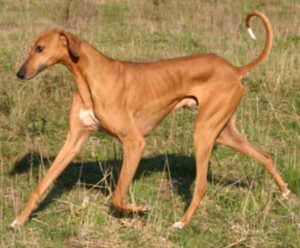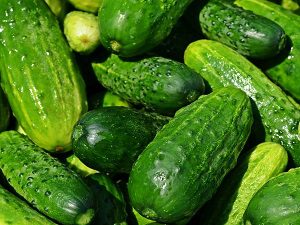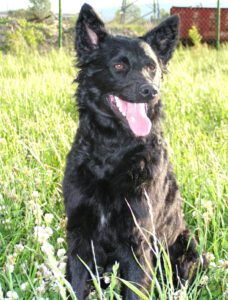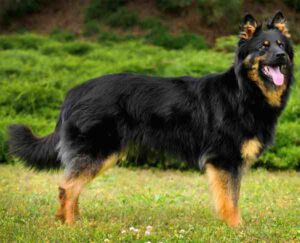The Bullmastiff dog is a large breed of domestic dog. It is a mastiff type dog, and was developed to guard estates. The breed was created by crossing the English Mastiff with the now extinct Old English Bulldog.
The Bullmastiff dogs were originated in Britain in the mid-1800s as estate guardians to ward off poachers. They were breed by gamekeepers for strength, size and speed using a cross of the tough, heavy and aggressive Bulldog of the 19th Century with the large, strong, less aggressive Mastiff.
As a result, the Bullmastiff is known as Gamekeeper’s Night Dog. The preferred color, by gamekeepers, was brindle, as this color works as a more effective camouflage, especially at night.
The Bullmastiff dog breed was deemed pure by the English Kennel Club in 1924, with a genetic background of approximately 60 percent Mastiff and 40 percent Bulldog.
American Kennel Club (AKC) recognized the breed in 1934. And in 1935, the first standard for the breed was approved. The standard has undergone several revisions since then, the most current version is available on the AKC website.
The diamond mining company De Beers imported Bullmastiff dog to South Africa in 1928 to guard the mines.
The Bullmastiff breed was bred to tackle and pin a poacher that comes on their land. An issue people have with the breed is that the dog may jump onto an unfamiliar person and tackle them until told to stop. This is why Bullmastiff owners must greet newcomers to the dog at their first interaction.[1]
Bullmastiff Dog Characteristics
The Bullmastiff dogs are large in size with a solid build and short muzzle. It is a brychycephalic breed. The term is describes a flat faced, shortened muzzled dog.
The head of the Bullmastiff is not as extreme as some other breeds, such as the pug however, and it is not common for the Bullmastiff to have any breathing issues like some other flatter faced breeds. A black mask is required and is a hallmark of the breed.
Coat of the Bullmastiff dog breed may appear in fawn, red, or brindle color. These are the only acceptable colors in the AKC standard. The fawn can range from a very light brown to reddish brown.
Red can range from light red-fawn to a dark, rich red. Brindles are a striped overly of the fawn or red. These dogs should have no white markings, except for on the chest where a little white is allowed.
Average body height of the mature dog is between 25 and 27 inches at the withers for male, and between 24 and 26 inches for the females. Average live body weight of the mature dog is between 50 and 60 kg for males, and between 45 and 54 kg for females.

Temperament
The ideal Bullmastiff dogs are fearless and confident, but obedient to their people’s wishes. They are smart and reliable, they can be an independent thinker, yet they want to please.
The Bullmastiff dogs are natural guardian of the home and family, and will respond instantly if they are threatened. They were actually bred to be silent watchdogs, so it’s unusual for them to bark.
Like other dogs, the Bullmastiff dogs also need early socialization. Exposure to many different people, sights, sounds and experiences are important. Proper socialization helps to ensure that your Bullmastiff puppy grows up to be a well-rounded dog.
Lifespan
Average lifespan of the Bullmastiff dog is between 8 and 10 years.
Feeding
How much a mature dog eats depends on it’s size, age, build, metabolism and activity level. Dogs are individuals, just like people, and they don’t all need the same amount of food.
The Bullmastiff dogs are large in size and they are pretty active. So, their diet should be formulated for a large sized breed with moderate exercise needs. Generally 3 1/8 to 4 1/8 cups of high-quality dog food will be enough for daily. Although, you can consult with a vet in your area for better recommendations.
Caring
Taking good care of the animals is very important for raising Bullmastiff dog. It is a low-energy dog, who can adapt well to most home environments, although their size makes them best suited to a house with fenced yard.
Their short muzzle makes the Bullmastiff prone to heat exhaustion and heatstroke. Avoid exercise during the heat of the day, and keep them indoors during hot or humid weather. Be sure they always have access to shade and fresh water when they’re outdoors.
Although they want to please, the Bullmastiff thinks for themselves and needs a confident trainer. Use positive reinforcement techniques, never physical punishment, but be firm and consistent in what you ask of them. Avoid repetitive training, or your Bullmastiff will get bored and start doing their own thing.
The Bullmastiff needs a firm hand when training, but they also need love and patience. When they’re trained, you’ll find that they’re a wonderful, caring, and loyal companion who will gladly risk their life to defend yours.
Health
The Bullmastiff dogs are generally healthy. But like all other dog breeds, they are also prone to certain health conditions.
Their common health problems include elbow dysplasia, hip dysplasia, hypothyroidism, progressive retinal atrophy, arthritis and gastric dilatation volvulus. Always try to keep good contact with a vet in your area.
| Breed Name | Bullmastiff |
| Other Names | None |
| Breed Size | Large |
| Height | Between 25 and 27 inches at the withers for male, and between 24 and 26 inches for the females |
| Weight | Between 50 and 60 kg for males, and between 45 and 54 kg for females |
| Good as pets | Yes |
| Climate Tolerance | All climates |
| Color | Red, fawn, brindle |
| Lifespan | Between 8 and 10 years |
| Good for children | Yes |
| Rarity | Common |
| Country of Origin | United Kingdom |






